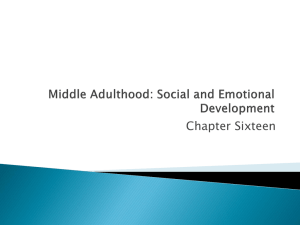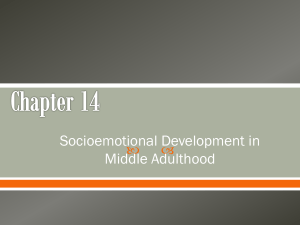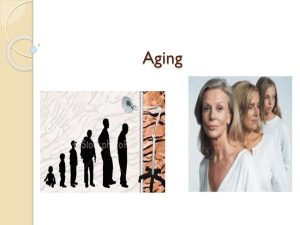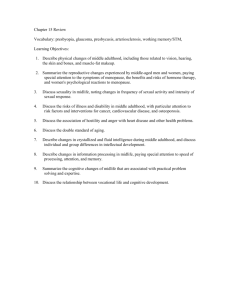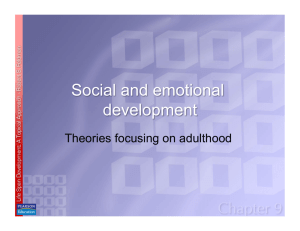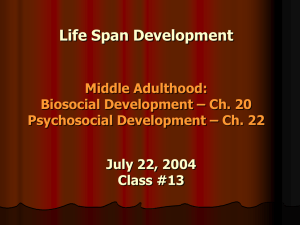CHAPTER 16 Middle Adulthood: Social and Emotional Development
advertisement
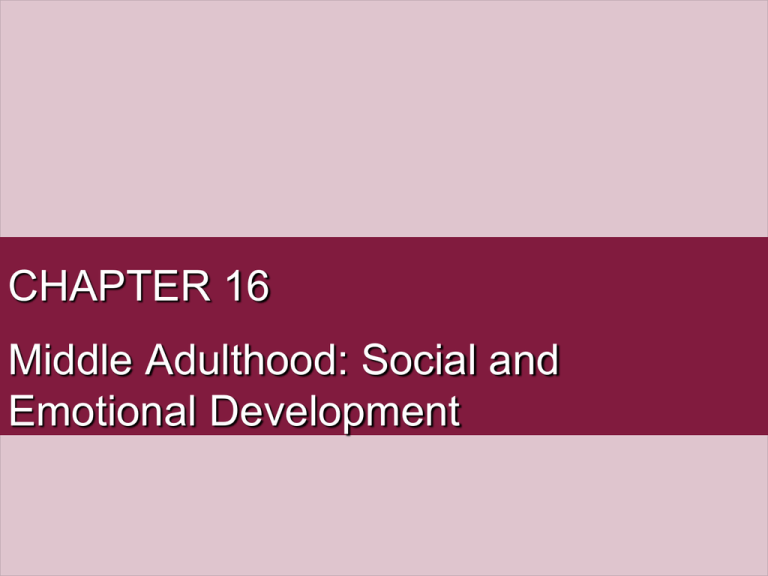
CHAPTER 16 Middle Adulthood: Social and Emotional Development Theories of Development in Middle Adulthood Erik Erikson’s Theory of Psychosocial Development • Believed major psychological challenge of the middle years is generativity versus stagnation • Generativity – ability to generate or produce; based on instinctual drive toward procreativity (bearing and rearing children) – can consist of parenting one’s own children, helping others with their children, being engaged in projects that will influence future generations • Stagnation – rejection of generativity drive can result in a life stripped of meaning and purpose Daniel Levinson’s Seasons • Midlife transition – The years from 40 to 45 – Psychological shift into middle adulthood often accompanied by a crisis during which people fear they have more to look back upon than forward to • Midlife crisis – Time of dramatic self-doubt and anxiety during which people sense the passing of their youth and become preoccupied with concern about the imminence of their own mortality – May be imposed from external factors such as downsizing Entering Midlife: Crisis, Turning Point, or Prime of Life? • Midlife usually identified around age 35 for women and age 40 for men; women reach it about five years earlier mostly due to reproductive awareness • Due to unrealized dreams and life losses, psychotherapy during this time should not be overlooked. • Midlife can be prime of life if the person has continued to develop in an area of expertise or interest – Little if any fluid intelligence lost and crystallized intelligence growing Entering Midlife: Crisis, Turning Point, or Prime of Life? (cont’d) • Middle-aged adults, especially professionals, are often earning more money than young adults. – Tend to be geographically and vocationally settled – Most have built systems of social support and may be involved in endearing romantic and social relationships as well as have children • Flip side of middle adulthood – The overwhelming responsibility of taking care of your own family, helping with your aging parents, and remaining in the workplace all at once The Life-Events Approach • Life-events approach – Focuses on the particular challenges that are likely to face people at this time of life rather than phases or stages • Stressful life events in middle adulthood – – – – – – – Death of a spouse, child, parent, or sibling Changes in health Caring for one’s parents Financial difficulties Concern about one’s appearance, weight, or aging Moving Change in employment; changes in relationships; changes in responsibilities at work The Life-Events Approach (cont’d) • Many middle-aged women do not experience “empty nest syndrome”. – Instead, they take advantage of their new time by being in the workplace and finding life satisfaction in other activities besides childrearing and homemaking • Supportive social network, positive attitude, and a sense of control help to mitigate the effects of stress and foster feelings of well-being among midlife adults. Stability and Change in Middle Adulthood Stability and Change in Middle Adulthood • Personalities tend to mature rather than be shaped by environmental conditions. • Expression of personality traits is influenced by culture. Are There Sudden Shifts in Personality? • The “big five” personality traits tend to show stability over time. • Some trends of group personality changes over the years, but introverted tend to remain introverted, extroverted tend to remain extroverted • Neuroticism declines over time; agreeableness and conscientiousness increase over time; extraversion and openness to new experience decline slightly over time Table 16-1, p. 336 Personality Themes among College-Educated Women • Women in their 40’s scored higher on personality scales than women in their 20’s. • Higher for women in their 60’s in the areas of identity certainty, confident power, and concern about aging • Personal distress toward aging decreases with age, suggesting older women have become more settled. Work in Middle Adulthood Job Satisfaction • Only 45% of American workers are satisfied with their jobs. • Job satisfaction increases steadily throughout adulthood. – Increased expertise and income – Workers are more realistic in middle adulthood • Blue collar workers – Report feelings of alienation and dissatisfaction due to supervisors treating them disrespectfully especially when supervisor is younger than them • Women balance work and home but still feel effects of “glass ceiling” Career Changes in Middle Adulthood • Most changes in careers occur during young adulthood due to responsibilities of middle adults’ life. • Most career changes in middle adulthood are shifts into related fields. • Radical shifts in career can be successful. • Crisis such as divorce, conflict with a coworker, or getting fired may force the middle adult to take any job he/she can find. Unemployment • Unemployed adults display lower physical and psychological well-being than their employed counterparts. • Unemployed middle-aged adults have lower well-being than unemployed young adults. • Unemployed middle-aged adults for whom work was more important, had fewer financial resources and social supports, and blamed themselves for the unemployment, fared the worst. • Older women will take lower-paying jobs as long as they like the work. Relationships in Middle Adulthood Evolving Parent-Child Relationships • Parents are stressed when adolescents do not exert self-control and they have to direct them in multiple areas of their life. • Children who are young adults may still be financially reliant upon their parents. – Some still live at home • Parents balance between staying in touch with the young adult and interfering with their life choices. • Living at home as a young adult differs according to culture as well as location. • Married children present new family members (in-laws) who may or may not enrich their parents’ lives. Grandparenting • Grandparents have to choose between reckless interference or painful neglect. • Having grandchildren is viewed as a positive life event. • Grandparents spend a higher proportion of their time with their grandchildren in recreational and educational activities. • Grandchildren tend to spend more time with their grandmothers than with their grandfathers all the way through adolescence. • Grandchildren tend to be more involved with maternal grandparents than paternal grandparents. Grandparenting (cont’d) • Grandparents tend to have resources such as trips available for grandchildren, but parents do the caretaking. • Grandparents have less influence on their grandchildren when they live with them. – Conflicts between adult children and grandparents ensue over parenting • Some grandparents end up the custodial parent to their grandchildren. – Changes the lifestyle of the middle adult and introduces emotional challenges as well as balancing issues Middle-Aged Children with Aging Parents • Most elderly parents live near one of their middle-aged children. • Most burden of taking care of the elderly parents falls on the middle-aged daughter • Sandwich generation refers to middle-aged daughter taking care of her own children and/or grandchildren as well as her aging parents • Middle-aged female may also be working, causing more stress; if lucky, she will have a sibling living nearby to help out Siblings • Most people in middle adulthood have at least one living sibling. • Nature of sibling relationships reflect the childhood relationship • Some sibling relationships get better as they take care of aging parents together. • On the other hand, sibling relationship may suffer if only one of the siblings is taking care of the elderly parent. Friends • Adults in middle adulthood tend to have fewer friends. • Middle-aged adults place value on the friends they do have. • Their friends tend to mirror them in interests, activities, and years of mutual experiences. • Male friends tend to be more competitive and less likely to be intimate than female friends. • Loss of a friend is felt very deeply.
